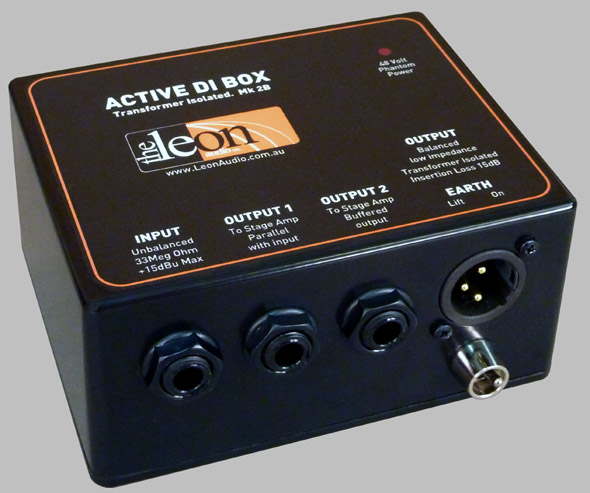
| | Home | Contact us | |
| Active D.I. Box |
| Description |
A Direct Box featuring the best of Active and Passive designs with none of their short comings.
- Genuine earth isolation
- Extremely high input impedance
- Low noise and distortion
- Transformer balanced output
The input is buffered by a class ďAĒ FET (Field Effect Transistor) amplifier
which has a 30 Meg ohm input impedance . The XLR output is isolated via
a custom made high performance audio transformer.
There are two unbalanced outputs for connection to a stage/musicianís
amplifier. The first is connected directly in parallel with the input.
The second provides a buffered output to prevent the musicianís stage amplifier
from over loading the instrumentís pickup and degrading performance.
The active FET input stage provides the benefits of low noise, low distortion and high input impedance, while the heavily screened output transformer provides very high isolation between the input and XLR sides of the D.I. Box. The transformer provides maximum immunity to external electrical interference and also reduces earth noise to an absolute minimum.
The D.I. is designed to operate without compromise when the earth lift
switch is lifted. Many other active D.I. boxes will not operate correctly,
or at all, when the earth switch is lifted as there is no return path for
the Phantom Power.
A DC/DC converter is used to power the active input stage via itís
own isolation transformer. This allows genuine earth isolation at all times.
Handling of high level inputs up to +15dBu means that a pad switch is not needed.
The D.I.ís high input impedance minimises loading of the signal source. This results in minimal loss of bass and treble when used with instruments with high source impedances. Piezo pickups are one example of high source impedances.
A high input impedance is also suitable for connection to low output
impedances such as keyboards or mixers. Impedance matching is not required,
nor is it even desirable, as we want to achieve the maximum possible signaltransfer,
not the maximum possible power transfer that a matched impedance
offers. Matched impedances are generally undesirable and not normally used
in audio systems.
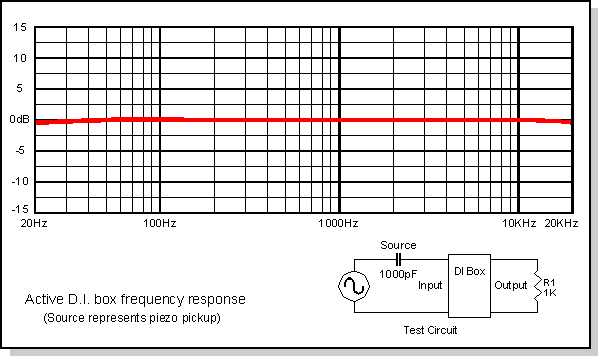
| Piezo Pickups |
Q: Why do many Piezo Pickups sound thin and bright?
A: Because the bass is heavily attenuated.
The capacitive characteristic of piezo pickups results in their output
level decreasing as frequency decreases when connected to a typical instrument
amplifier which has an input impedance of about 1 Megohm.
This is due to excessive loading of the pickup by the amplifier which
was never designed to work with piezo pickups.
An extremely high load impedance, typically greater than 20 Meg ohms, is needed to provide negligible loss of bass frequencies.
The above situation is further compounded by connecting the piezo pickup
to a D.I. box. The total load seen by the pickup is now that of the DI
box and the instrument amplifier in parallel.
The input impedance of a typical D.I. is 100K-200K ohms, which results
in a very heavy load on the piezo pickup and consequentially a heavy loss
of low frequencies.
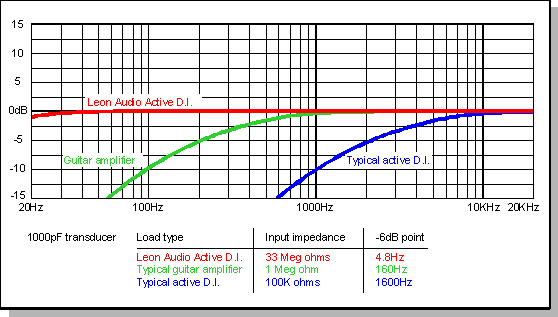
Piezo pickup frequency response Vs various load impedances
The solution is to use a D.I. box which provides an extremely high input
impedance and a buffered output to drive to the instrument amplifier. With
this arrangement, the piezo pickup is only loaded by the input impedance
of the D.I. box, and everybody is happy.
The Leon Audio Active DI box is one such solution.
Attempts to recover the lost bass of an overloaded Piezo pickup using
conventional tone controls is usually less than successful.
The problem is that the bass rolls off at the rate of 6dB per octave,
and conventional tone controls can not create an inverse of this roll off.
Curve #2 in the graph below shows the response of a Piezo pickup rolling
off at 6dB per octave.
Curve #1 is a typical bass tone control set at full boost.
The centre curve shows the bass boost applied to the signal lacking
in bass. The result is still lacking in bass but more importantly, it is
far from flat.
It is much better to cure the disease than to treat the symptoms.
Using a DI box with a very high input impedance to prevent the loss
of bass in the first place, is much better than trying to patch it up later.

Low frequency roll off showing poor bass response even with
+15dB of EQ
| Two Output Jacks |
A typical D.I. configuration has an instrument plugged into the input
of the D.I., and a mixing desk into the XLR output. A stage amplifier can
be connected to either the direct or buffered output jacks.
If the stage amplifier is connected to the Buffered output
jack, the instrument will only see the 30 Megohm input impedance of the
D.I. box. This results in the best possible frequency response when using
high impedance pickups such as piezos. An extra octave of low end, or part
thereof, can be obtained, compared to a regular D.I. Box. This may cause
problems for the musician as his stage sound will be different.
If this increased low end is unacceptable, connect the stage amplifier
to the Direct output jack. The instrument will now be loaded by
the input of the stage amplifier. Depending on the type of pickup used,
large amounts of bass roll-off may occur. The Direct output jack was provided
so that the musician can retain their normal but degraded sound that they
are used to.
Connect the stage amplifier to the Buffered output whenever
possible.
| Power Source |
Power for the FET input amplifier needs to be returned to the XLR connector.
This can not be achieved when the Earth Lift switch is open. There are
4 possible options ...
1: Use batteries. This option was considered unacceptable in a professional
D.I. box
2: Do what other active D.I. boxes do and allow the Phantom Power to
return via the instrumentís mains earth connection.
A great way to pick up lots of electrical noise.
3: Do what other active D.I. boxes do and use a partial Earth Lift.
This concept works well in the showroom. It fails in the real world when
electrically noisy environments are encountered.
4: Use a complex isolated power source for the FET input amplifier.
Option 4 was chosen as it is the only one that offers genuine earth isolation between the input and the XLR output of the DI Box.
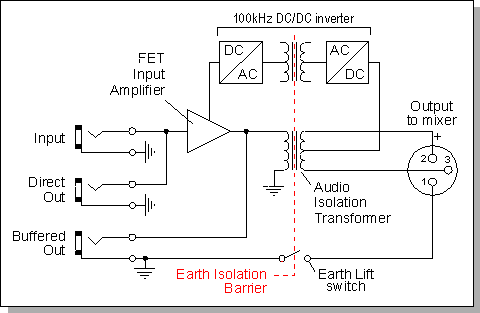
Block Diagram of the Active D.I. Box
The drawing above shows that there is no direct electrical connection
across the Earth Isolation Barrier.
A DC/DC inverter is used to get the FET amplifierís power across Earth
Isolation Barrier. Phantom Power is first extracted from the centre tap
on the bifilar wound secondary of the audio transformer. This drives a
DC/AC converter running at 100kHz which in turn drives a small power transformer.
The resultant 100kHz AC voltage on the secondary of the power transformer
is rectified and filtered to provide 18 volts DC to run the FET amplifier.
As a result, there is no interruption to the FETís power supply when the
Earth Lift switch is operated.
As the FET amplifier is operating on an 18 volt supply, it is able to
handle much higher signal levels than if it were operating from a 9 volt
supply, such as a battery.
This means that the DI Box can handle input signals up to +15dBu without
the need for an input Pad switch. (0dBu = 0.775Volts)
| What's in a D.I. Box? |
D.I. Boxes are constructed using one of two common techniques.
- The first type uses electronic circuitry and are known as active D.I. Boxes. They require either Phantom Power or a battery supply.
- The second type uses an audio transformer and are known as either transformer or passive D.I. Boxes. They require no power supply.
![]() 1. Impedance
Conversion.
1. Impedance
Conversion.
![]() 2. Unbalanced
to
balanced conversion.
2. Unbalanced
to
balanced conversion.
![]() 3. Earth
isolation.
3. Earth
isolation.
![]() 1. Impedance Conversion.
1. Impedance Conversion.
The medium or high impedance of a signal source is converted to a low
impedance suitable for feeding down a long multicore to a mixing deskís
microphone input. A low impedance enables long cable runs, with very little
quality loss, and also low susceptibility to external electrical interference
which can cause hum and buzzes.
A D.I. box should provide a high input impedance for connection to a signal source, and a low output impedance for connection to the microphone input of a mixing desk.
![]() 2. Unbalanced To Balanced Conversion.
2. Unbalanced To Balanced Conversion.
The unbalanced (2 conductor) wiring of a signal source is converted
to the balanced (3 conductor) wiring of a mixing deskís microphone input.
A balanced cable provides good rejection of electrical interference, while
an unbalanced cable does not. Active D.I. Boxes are potentially capable
of providing excellent unbalanced to balanced conversion, but due to cost
restrictions, most are poor performers in this area. D.I. Boxes that incorporate
transformers provide excellent unbalanced to balanced conversion.
![]() 3. Earth Isolation.
3. Earth Isolation.
A D.I. Box provides isolation between the earth wiring of a signal
source (e.g. musical instrument) and the sound system to which it is being
connected. This prevents earth loops from occuring.
Active D.I. Boxes are usually very poor at providing good earth isolation, because there is usually a direct electrical path between the instrument and the sound system, even if its earth lift switch is lifted. The Leon Audio Active D.I. Box uses a quality transformer to provide very good earth isolation.
D.I. boxes have an earth lift switch to allow the input and output earths of the D.I. box to be disconnected, so that earth loops can be broken. Disconnecting the signal (audio) earth is not a safety issue, as the Protective Earths in all the mains cables are still connected and fully functional.
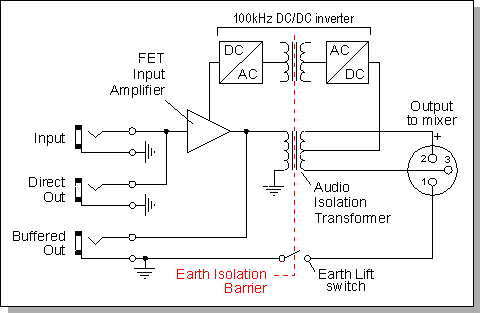
Earth isolation barrier of the Active D.I. Box
- If the instrument is connected to the mains earth, open the Earth Lift Switch.
- If there is no mains earth connected to the instrument, close the Earth Lift Switch.
| Active D.I. Specifications |
| Specifications
Frequency Response
Nominal Input Impedance
Power Supply Supply Current
Weight Dimensions |
0dBu=0.775Volts
20Hz - 20kHz ±0.15dB
33,000,000 ohms
48V Phantom Power
|
| 2 Year Warranty |
The Leon Audio Active D.I. Boxes are guaranteed for two years from date
of original purchase against defects in workmanship and materials.
If such malfunction occurs, the item will be repaired or replaced (at
our option) without charge for materials or labour if delivered prepaid
to THE LEON AUDIO COMPANY. Unit will
be returned prepaid. Warranty does not cover finish or malfunction due
to abuse or operation at other than specified conditions. Repairs by other
than THE LEON AUDIO COMPANY or authorised agents will void this guarantee
| Brochure |
| Download brochure for the Active
D.I. Box.
(130Kb) in Adobe Acrobat format. |
| Home | To top | Contact us |
Copyright © 2020. The Leon Audio Company. All rights reserved.
